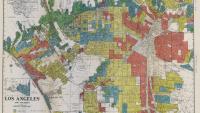Historical redlining and birth outcomes in California

Research and lived experiences have documented the lasting effects of residential segregation. Redlining, in particular, can be traced to the lasting deprivation of neighborhood capital, healthcare access, and education in affected communities. After the Great Depression in the 1930s, the federal government provided long-term mortgages for new home buyers. To determine areas where individuals were likely to default on loans, maps were draw and some communities “redlined” to highlight areas of perceived investment risk. In these maps, largely drawn based on prior home values, industry, racism, anti-immigrant sentiment, red areas indicated highest risk. Recent studies have turned their attention to present-day health effects of redlining. In looking at birth outcomes in three Californian cities over a ten-year (2006-2015) period, Nardone et al. seek to expand our understanding of historic segregation and health.
In order to determine the relationship between historic redlining and birth outcomes, the researchers drew their sample from all births recorded in California between January 2006 and December 2015, making sure to include both maternal and infant data. They then matched maternal addresses to historic redlining maps such that each birth corresponded to one of the original redlining map grades. These grades represented the perceived investment potential, and ranged from A to D, with D being a ‘red’ (highest risk) and A being a ‘green’ (lowest risk) zone. In terms of geographic scope, the authors focused on the birth outcomes in this time period in the Los Angeles, Oakland, and San Francisco metropolitan areas.
The study found that birth outcomes were indeed tied to redlining in the three Californian cities. Above all, the authors point to the racial disparities related to these outcomes: as the grade of the redlined tract decreased (from A to D), the numbers of Hispanic and Black mothers increased. At the same time, the numbers of non-Hispanic White and Asian Pacific Islander mothers decreased as the neighborhood grade worsened. Mothers in redlined areas were more likely to pay for delivery care through Medicaid, receive Special Supplemental Nutrition Program for Women, Infants, and Children (WIC), and were less likely to have a bachelor’s degree compared to the mothers who gave birth in higher-graded areas (i.e., C, B, and A). Furthermore, the prevalence of preterm birth, small-for-gestational age birth and infant mortality were significantly higher in grade C and D neighborhoods compared to grade A. The authors assert that future research should determine if these trends are occurring elsewhere in historically redlined areas in the country.
Reference:
Nardone AL, Casey JA, Rudolph KE, Karasek D, Mujahid M, Morello-Frosch R. Associations between historical redlining and birth outcomes from 2006 through 2015 in California. PLoS ONE 2020;15(8): e0237241.